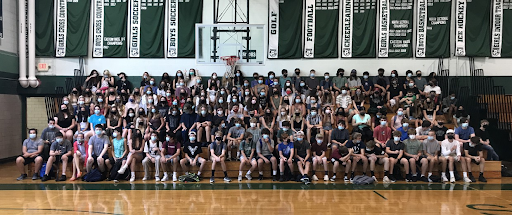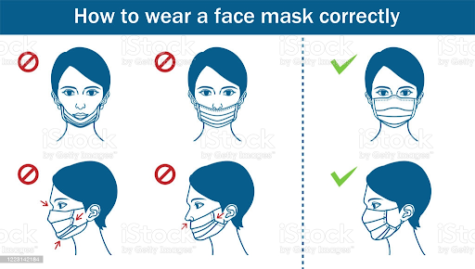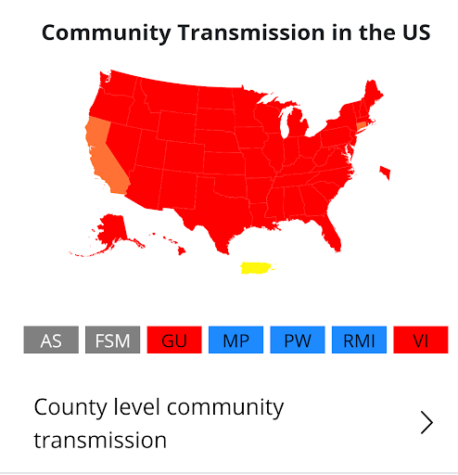To Mask or Not to Mask: Why More Teens Are Letting the Masks Slip Down

Photo Source: Pentucket Regional High School Website
October 24, 2021
With increasing numbers of American citizens being vaccinated, high school students of the 2021 school year are more than ready to ditch the masks and return to ‘normal’ once and for all.
However, the continued threats of the Delta variant, and still significant numbers of cases and fatalities, have raised a plethora of concerns regarding the rising prevalence of improper mask-wearing in school, the resolution of which could define the pandemic’s long-awaited conclusion.

Walk into any high school across the nation, and one is likely to be met with choruses of countless teachers reminding their students that “it goes over your nose, too.”
Current guidelines from the Commissioner of Education require masks in schools until the necessary 80% or higher rate of vaccination is reached, or as Triton Middle School teacher Michelle Carley says, “they are required to be worn in the classroom fully covering the nose, not slipping down.”
The CDC itself has recommended that, as of August 2021, “everyone who is able, including fully vaccinated people, should wear masks in public indoor places in areas of substantial or high transmission.” Despite this mandate, however, increased disinterest in proper mask-wearing remains a glaring concern in the classroom.
When asked if she has noticed an increase in improper proper mask-wearing in school, Pentucket High School senior Emily Brankman responded, “Yes, oh my god, every day, it’s so annoying and frustrating. I empathize with why they are frustrated at this point to some degree, but we all have to do it. it’s better to do the right thing because at the end of the day this is the only way to get through the situation and hopefully end it.”
Carley, who has dealt with this situation first-hand in her classroom, has similarly called it “an enormous problem.” “I think that it is difficult,” says Carley, “and I can totally relate that when you’re talking a lot, or physically exerting yourself, and it’s hot behind the mask, then they prefer to not wear it. But it is what it is, and they have to.” As Carley explains, “even if one or two students are doing it in the classroom with twenty other students around them, it can create a problem with community spread.”
While 77% of Americans have now received at least one vaccine, data from the CDC daily covid tracker still shows high levels of community transmission in the United States, as well as new case and death levels as high as 100,000 and 20,000, respectively.

Furthermore, though the 80% benchmark is necessary for unmasking, data from the West Newbury Police department has shown that for individuals between the ages of 16-19 across Groveland, Merrimac, and West Newbury, the average vaccination rate falls short of reaching this quota at just 61%.
These statistics, however, have seemingly lost much of their impression on the younger generation.
Carley says, “with the younger kids, they think ‘I’m not going to get really sick anyway, so it’s not really a big deal,” even when CDC data has shown that people under age 30 accounted for more than 20% of COVID-19 cases over the summer of 2021 and were seen as more likely to transmit the virus than others, a trend which has continued into the fall.
Why the negligence, then? In Carley’s view, “I think it’s just because they aren’t seeing as much of the deaths or illness, even when they are happening around them, so it’s not directly affecting them.” Carley also noted, “the tendency with adolescents is that they are still learning to be empathetic and selfless, and it’s harder for them to think of others and put themselves in other shoes, and the dangers or risks they might be causing for them.”
Brankman holds a similar view of the situation: “I think because the first summer of covid everyone was so scared about it, the people who did break the mandate and the quarantines were all looked down upon, but now it’s been two years, so people want to think things are better and they act like things are better, even when we are not at the stage where we can do that safely yet.”
No matter the personal feelings behind the matter, the facts still stand. Until the pandemic is truly over and cases sink to safe levels of transmission, it remains highly advisable for high school students to continue masking-up, which, as Brankman says, will be “necessary” towards achieving a long-awaited conclusion to the devastating Covid-19 pandemic. If this can be accomplished, then hopefully, someday soon, high school students may be able to ditch the masks for good.











Reese Gallant • Nov 2, 2021 at 10:34 am
I like this article because this is seen as a problem at Pentucket. I agree with what this article talks about. For the students who care for their safety and the safety of others are effected by the students that do not wear their masks. The students who want a normal school year are frustrated with the way others use their masks and their disbelief in the pandemic. This is a continued conversation here at Pentucket.
paolo orlando • Oct 29, 2021 at 12:22 pm
i like this article a lot because without the masks that are being worn than covid will strike all of us. no one wants covid, but covid wants us and i think kids mentallity now is just “covid is over its been so long” so they decide to not wear the mask properly.
ella • Oct 25, 2021 at 1:10 pm
I completely agree with these statements I think kids are having a hard time processing that the pandemic is still going on and will continue if we all don’t do are part. Everyone is so tired of wearing masks especially at school we constantly have to help pulling it up and it can be hard to talk in and that’s why I think so many kids don’t wear it over their nose just because it is a inconvenience to them.
Ella Borrelli • Oct 25, 2021 at 1:08 pm
I completely agree with these statements I think kids are having a hard time processing that the pandemic is still going on and will continue if we all don’t do are part. Everyone is so tired of wearing masks especially at school we constantly have to help pulling it up and it can be hard to talk in and that’s why I think so many kids don’t wear it over their nose just because it is a inconvenience to them.
Jack Nottingham • Oct 24, 2021 at 5:43 pm
I think this article is very well written, and I agree that masks are a controversial problem in schools all around the country.